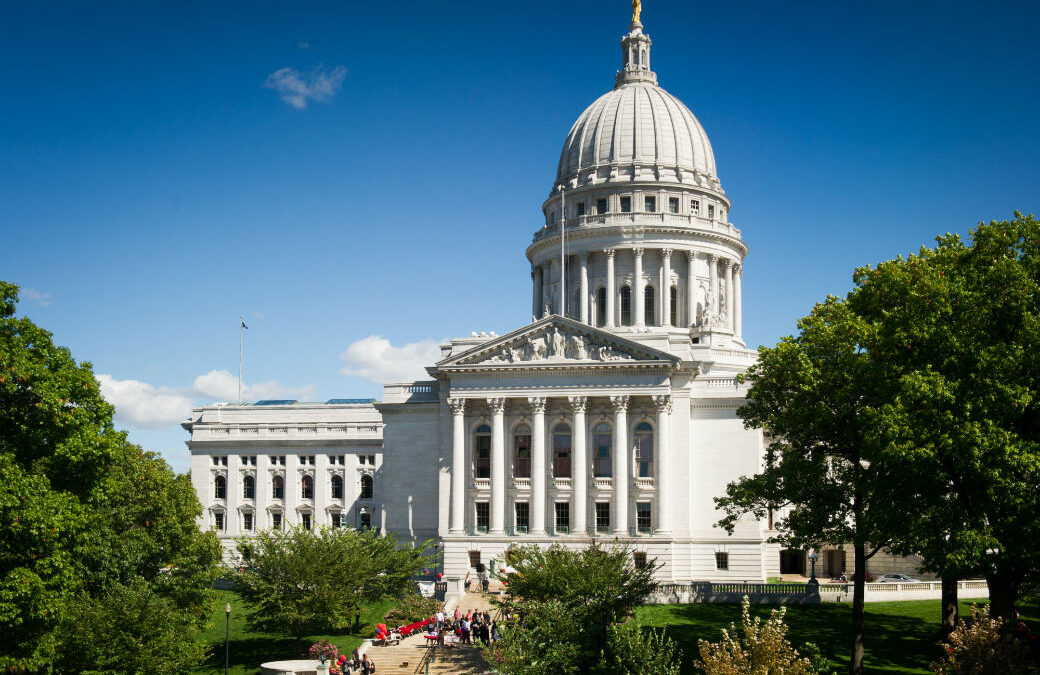As the legislature wraps up for this session, RENEW is celebrating several victories and reflecting on some of the other renewable energy measures being considered by the state legislature.
Big Win for Electric Vehicle Infrastructure
Senate Bill 791, the Electric Vehicle Charging Bill, passed the legislature with several amendments. The legislation exempts private entities that develop charging stations from being regulated as a public utility but allows them to measure the cost of electricity used for charging EVs by the kilowatt hour (kWh). Establishing this new kWh standard to calculate how much electricity is used, rather than how long it takes to charge the vehicle, provides an essential uniform requirement for the industry. It is also required by the National Electric Vehicle Infrastructure (NEVI) Program for Wisconsin to qualify for $78 million dollars in federal funding, an 80% cost share, for level 3 chargers to build corridors for charging. RENEW will be developing a detailed overview of the passed legislation for those interested in more information. The bill received bipartisan support and limited opposition. In other actions related to electric vehicles, the Legislature also passed SB 792, which establishes the infrastructure program and enables the state to utilize the federal NEVI funding. Additionally, with the passage of SB 617, the DOT will issue registration plates or stickers for existing license plates that indicate the vehicle is electric.
Progress on Community Solar
The community solar bill, Assembly Bill 258, did not pass either the Senate or Assembly but did get a hearing in the Assembly Committee on Energy & Utilities. This is a significant development considering the heavy opposition from Wisconsin Utilities. The public hearing was a great opportunity for the benefits of community solar to be shared with state legislators. During the hearing, supporters of community solar were able to answer questions, correct misinformation, and show their unity and strength. Establishing a community solar program for renewable energy generation is essential for those without the option to install panels on their own roofs, or the financing necessary to cover costs. Under the community solar arrangement, the participants subscribe to the developed project and receive a credit on their electric bill for solar electricity generated on panels installed in a community setting. The developer arranges permitting, financing, and installation, as well as maintenance. If passed, the legislation would require approval of the location by local governments and be limited to 5 megawatts or about 26 acres. Each project would also require at least four subscribers. With fierce opposition in some areas to larger utility-scale operations, the community solar model is a better fit.
Other Legislative Wins
There were numerous bills that aimed to limit renewable energy development, including restrictive sitting and increased regulation. They did not pass, and in most cases, did not receive a hearing. These bills ultimately died in committee.
Assembly Joint Resolution 6
Assembly Joint Resolution 6 (AJR6) would give the Wisconsin Legislature control over how federal funds are spent, rather than the Governor, on behalf of the state. Recent examples of federal funds distributed to the states include the Inflation Reduction Act (IRA) and the Bipartisan Infrastructure Law (BIL), both have benefited Wisconsin’s clean economy. The Wisconsin constitution directs the Governor, as head of state, to oversee disbursement. In order to change the constitution, identical legislation has to pass the legislature twice in a row and then be considered by state voters. Because it is not regular legislation but a joint resolution of the legislature, the Governor does not have veto power. After the passage, the resolution language will become the referendum during an upcoming election, with the resolution language being the exact question asked. If voters approve the referendum, the state will need to modify the constitution. The consequences of this change can impact many efforts, such as conservation measures, disaster relief funds, higher education, and more. The earliest statewide election when this referendum can be placed on the ballot is the August primary. Efforts are on the way to provide information and educate the voters on the impact the change could have on issues of importance to them.

